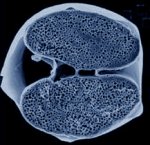Doushantuo Formation
Fossils of the Precambrian Doushantuo Formation, Guizhuo Province, ChinaGeologic Time: Ediacaran or Vendian Period of the Neoproterozoic Era some 600 to 555 million years ago |
The page within: Related Interest: |
The Ediacaran Doushantuo Formation - the Hunt for Precambrian Life |
|||||||
| The Doushantuo Formation is a recently discovered lagerstätte in Guizhou Province, China that is most notable for its scientific contributions in the hunt for Precambrian life. Doushantuo is of particular interest because its fossils, dating from about 565 to 590 million years ago, predate the Cambrian Explosion by at least 20 million years. The most fossiliferous zones are estimated to be 570 million years old.
The biota of Doushantuo comprises algae, multicellular thallophytes (seaweeds), acritarchs, and cyanophytes, poriferans (sponges), cnidarians, including possible tabulate corals. Most important are the putative bilateral animal embryos. Some of these possible animal embryos apparently record the early stage of cellular division. There are also putative bilateral animal embryos, some of which appear to be in an early stage of cellular division. This is also in dispute, as Baily and co-workers, (2007) argued that the putative embryos, Parapandorian, and putative eggs, Megasphaera, could be fossils of giant sulfur bacteria similar to Thiomargarita, a bacterium so large that it is visible to the naked eye. Baily's interpretation also provides a mechanism for phosphatic fossilization found at Doushantuo through microbially mediated phosphate precipitation by the bacteria. Of particular interest is that putative embryos from Doushantuo Formation can be digitally dissected into their component cells, and even the sub-cellular organelles examined. The fossils bear similarities to modern organisms at early stages of development. However, they lack The absence of ectodermal and mesodermal sheets of tissue at later stages, suggesting that these animals are very primitive, and that they are preserved remains of the embryos of a stem group of metazoans. |
|
||||||
Fossil
Museum Navigation:
Home Geological Time Paleobiology Geological History Tree of Life Fossil Sites Fossils Evolution Fossil Record Museum Fossils |

